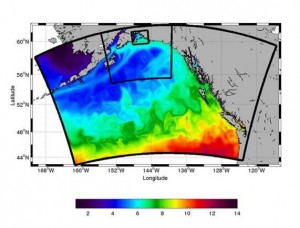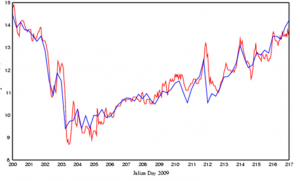A major goal of the observing system in Prince William Sound is the ability to instantly deliver information on physical and biological conditions such as:
- Wind speed
- Air temperature
- Precipitation
- Ocean currents and temp
- Tide height
- Water salinity
- Modeled forecasts of anticipated conditions
Forecasts for the atmospheric conditions in the Prince William Sound region have been developed using the Weather Forecasting and Research (WRF) model with a 4 km resolution.
Regional Ocean Modeling System (ROMS)
The JPL/UCLA group applied the Regional Ocean Modeling System (ROMS) to PWS. ROMS has also been successfully used for the California coast and it represents an evolution from the family of terrain-following, vertical coordinate models. AOOS provided limited funding for the data assimilation of the ROMS model, and a grant from NASA continued the development of this key component through 2010.
Technical information about ROMS
ROMS solves the primitive equations under the hydrostatic and Boussinesq approximations. ROMS is discretized in coastline- and terrain-following curvilinear coordinates.
A major new feature of ROMS is the 3-dimensional variational (3DVAR) data assimilation system in ROMS. A Pacific basin-scale ROMS has been developed with a resolution of 12.5-km. The Pacific basin-scale ROMS provided the needed boundary conditions for the PWS ROMS configurations, which consist of three nested ROMS domains with 12-km, 4-km, and 1.3-km over the Pacific Northeast, Gulf of Alaska, and PWS, respectively. We are also in the process of developing a tidal modeling component in ROMS, so the real-time sea level can be predicted in addition to circulation fields.


